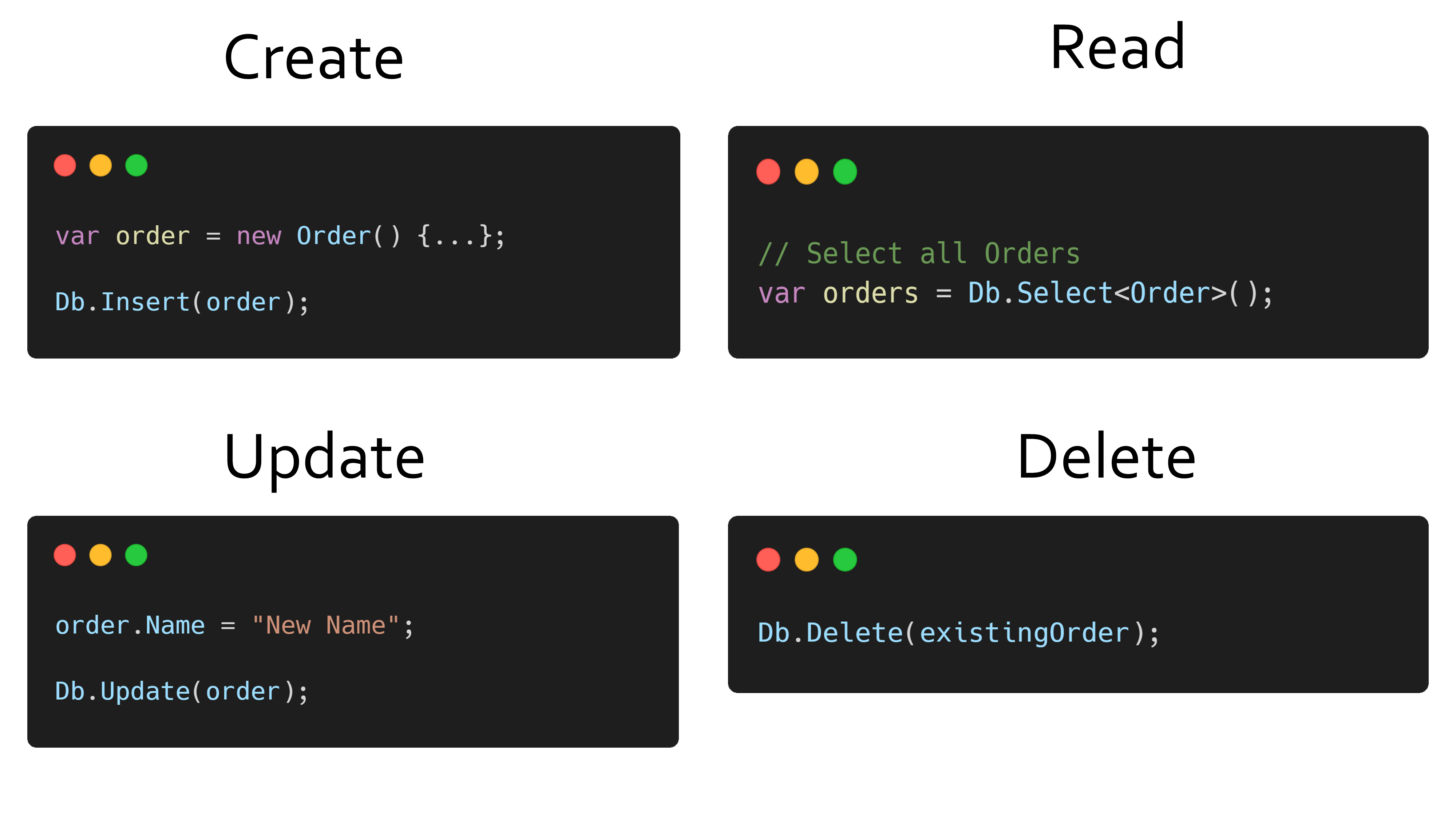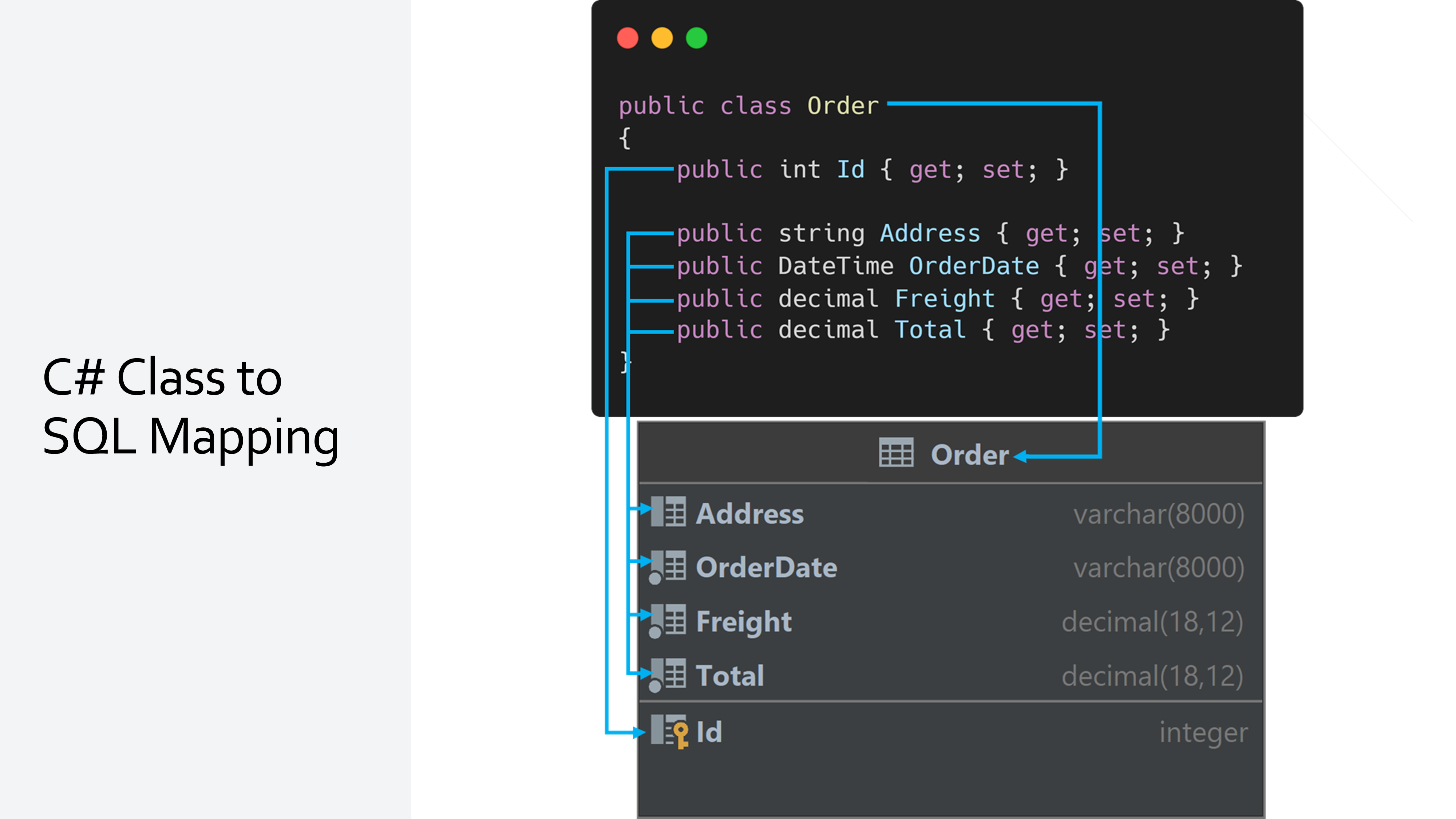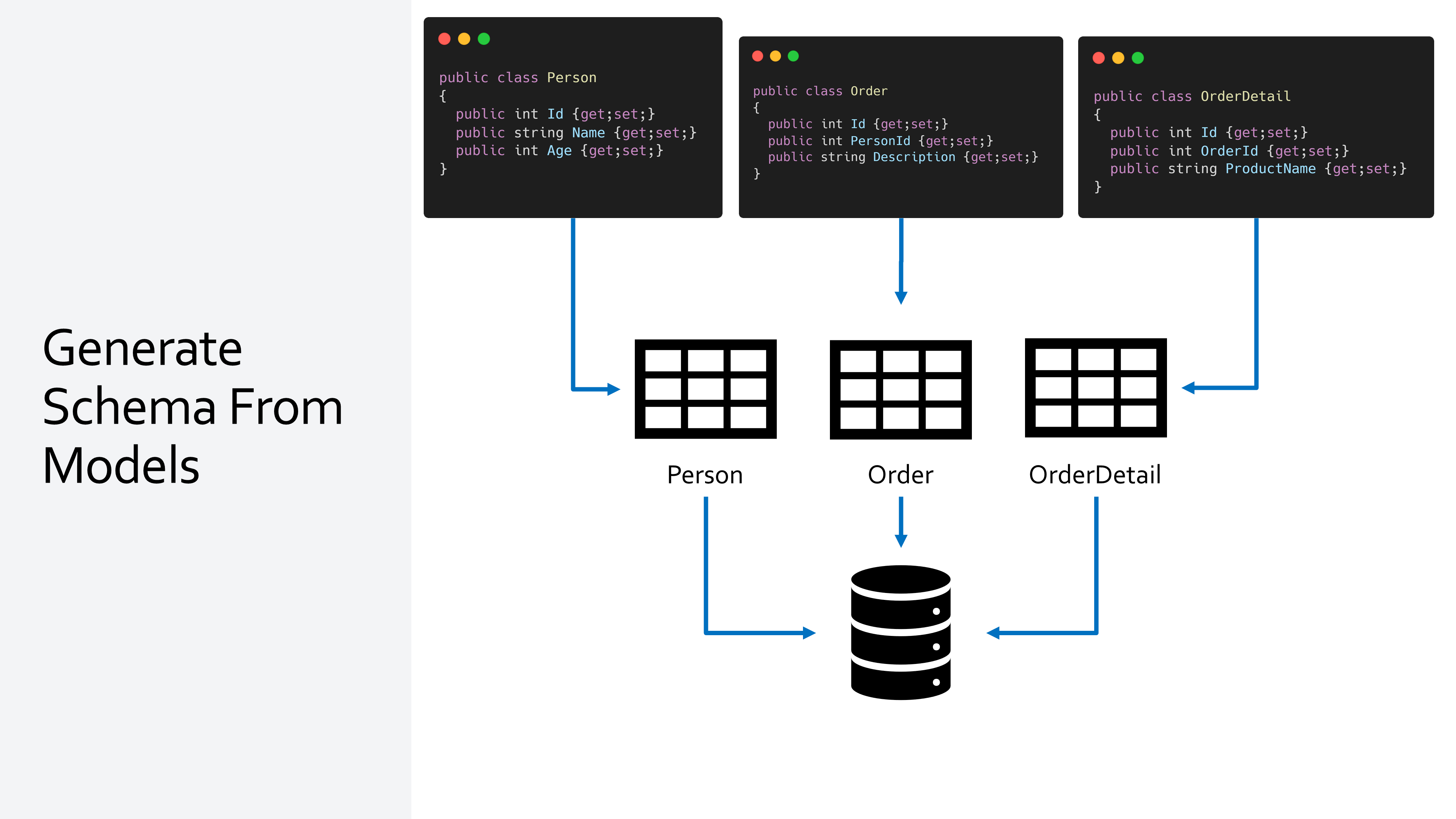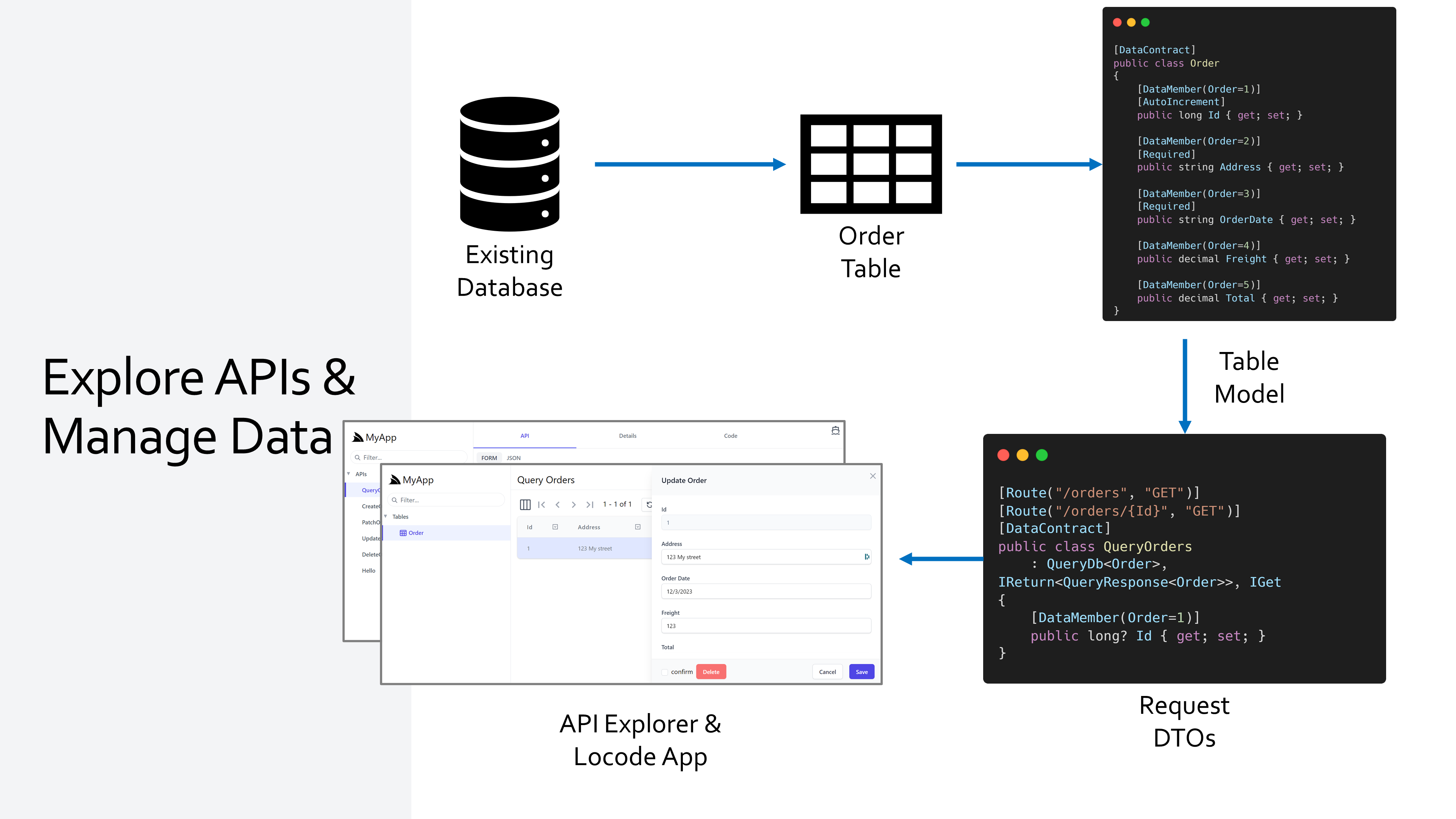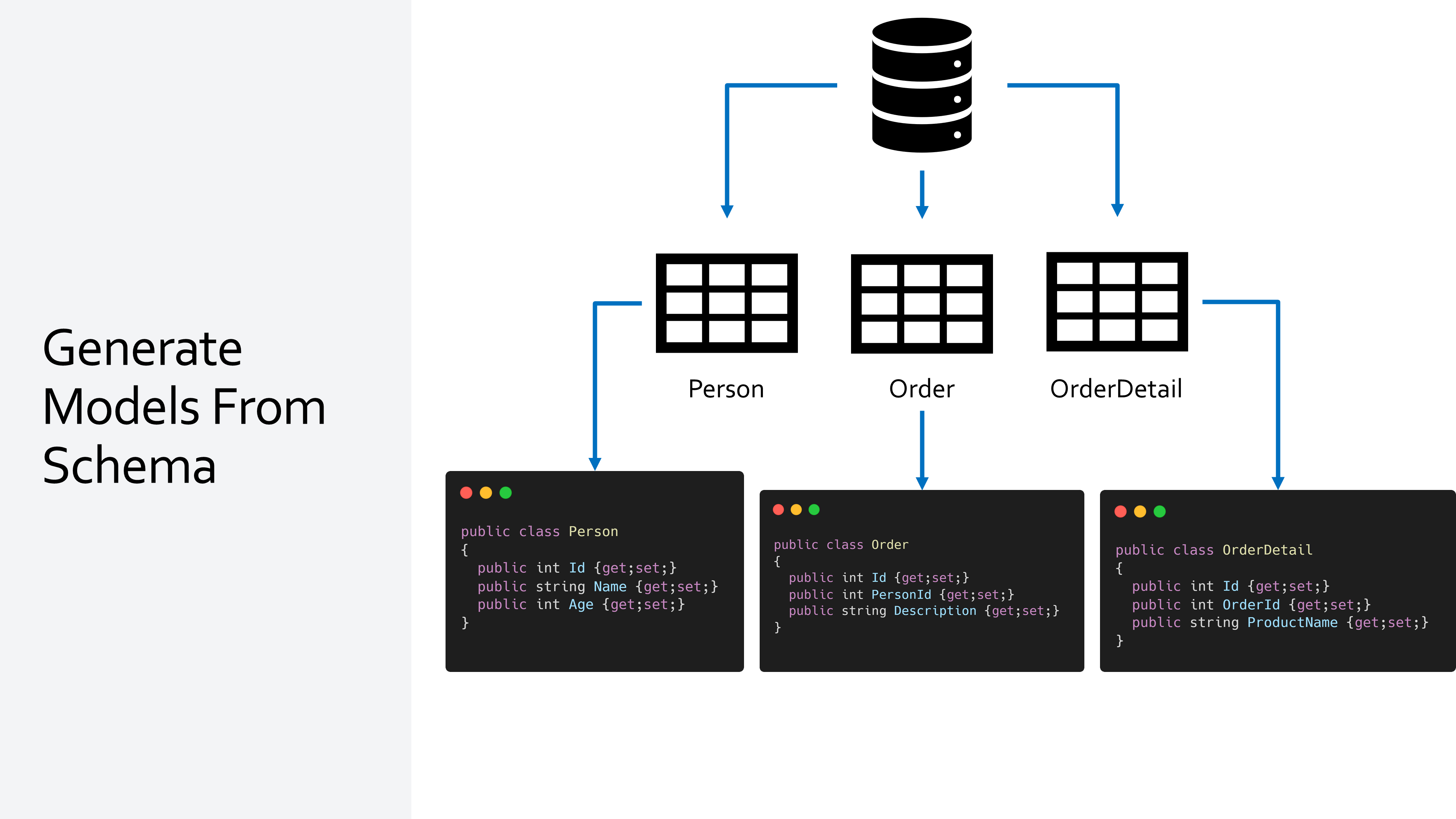After installing OrmLite we now need to configure OrmLite's DB Connection Factory containing the RDBMS Dialect you want to use and the primary DB connection string you wish to connect to.
Fluent Configuration Model
OrmLite's new Fluent Configuration Model is available from ServiceStack v8.9 which is modelled after
ASP.NET Core's familiar services.Add*() pattern and provides a more intuitive and discoverable way to configure your
database connections, with strongly-typed options for each RDBMS provider.
It starts with the AddOrmLite() extension method to configure the default IDbConnectionFactory
dependency by combining it with RDBMS provider-specific methods for the RDBMS you wish to use:
UseSqlite()in ServiceStack.OrmLite.Sqlite.DataUsePostgres()in ServiceStack.OrmLite.PostgreSQLUseSqlServer()in ServiceStack.OrmLite.SqlServer.DataUseMySql()in ServiceStack.OrmLite.MySqlUseMySqlConnector()in ServiceStack.OrmLite.MySqlConnectorUseOracle()in ServiceStack.OrmLite.Oracle (community supported)UseFirebird()in ServiceStack.OrmLite.Firebird (community supported)
Each provider method accepts a connection string and an optional configuration callback that lets you customize the dialect's behavior with IntelliSense support.
SQLite
services.AddOrmLite(options => options.UseSqlite(connectionString));
Each RDBMS provider can be further customized to change its defaults with:
services.AddOrmLite(options => options.UseSqlite(connectionString, dialect => {
// Default SQLite Configuration:
dialect.UseJson = true;
dialect.UseUtc = true;
dialect.EnableWal = true;
dialect.EnableForeignKeys = true;
dialect.BusyTimeout = TimeSpan.FromSeconds(30);
})
);
PostgreSQL
services.AddOrmLite(options => options.UsePostgres(connectionString));
With Dialect Configuration:
services.AddOrmLite(options => options.UsePostgres(connString, dialect => {
// Default PostgreSQL Configuration:
dialect.UseJson = true;
// Use snake_case PostgreSQL Naming Strategy
// dialect.NamingStrategy = new PostgreSqlNamingStrategy();
})
);
SQL Server
services.AddOrmLite(options => options.UseSqlServer(connectionString));
With Dialect Configuration:
services.AddOrmLite(options => options.UseSqlServer(connString, dialect => {
// Default SQL Server Configuration:
dialect.UseJson = true;
})
);
Uses Latest SQL Server at each .NET LTS Release
To keep it modern and predictable, this will use the latest SQL Server Dialect that was released at the time of each
major .NET LTS versions, currently SqlServer2022OrmLiteDialectProvider, which we'll keep until the next .NET LTS release.
Although the 2022 dialect is also compatible with every SQL Server version from 2016+.
To use an explicit version of SQL Server you can use the generic overload that best matches your version:
services.AddOrmLite(options =>
options.UseSqlServer<SqlServer2014OrmLiteDialectProvider>(connString));
MySQL
services.AddOrmLite(options => options.UseMySql(connectionString));
With Dialect Configuration:
services.AddOrmLite(options => options.UseMySql(connectionString, dialect => {
// Default MySql Configuration:
dialect.UseJson = true;
})
);
For MySqlConnector use:
services.AddOrmLite(options => options.AddMySqlConnector(connectionString));
Named Connections
The new OrmLite configuration model also streamlines support for named connections, allowing you to register multiple database connections with unique identifiers in a single fluent configuration chain, e.g:
services.AddOrmLite(options => {
options.UseSqlite(":memory:")
.ConfigureJson(json => {
json.DefaultSerializer = JsonSerializerType.ServiceStackJson;
});
})
.AddSqlite("db1", "db1.sqlite")
.AddSqlite("db2", "db2.sqlite")
.AddPostgres("reporting", PostgreSqlDb.Connection)
.AddSqlServer("analytics", SqlServerDb.Connection)
.AddSqlServer<SqlServer2014OrmLiteDialectProvider>(
"legacy-analytics", SqlServerDb.Connection)
.AddMySql("wordpress", MySqlDb.Connection)
.AddMySqlConnector("drupal", MySqlDb.Connection)
.AddOracle("enterprise", OracleDb.Connection)
.AddFirebird("firebird", FirebirdDb.Connection);
Complex Type JSON Serialization
The new configuration model uses a configurable JsonComplexTypeSerializer where you can change the default
JSON Serializer OrmLite should use for serializing Complex Types as well as fine-grain control over which types should
use which serializer by using the ConfigureJson() extension method on each provider.
services.AddOrmLite(options => {
options.UsePostgres(connectionString)
.ConfigureJson(json => {
// Default JSON Complex Type Serializer Configuration
json.DefaultSerializer = JsonSerializerType.ServiceStackJson;
json.JsonObjectTypes = [
typeof(object),
typeof(List<object>),
typeof(Dictionary<string, object?>),
];
json.SystemJsonTypes = [];
json.ServiceStackJsonTypes = [];
});
})
By default OrmLite uses ServiceStack.Text JSON Serializer which is less strict and more resilient than
System.Text.Json for handling versioning of Types, e.g. an int Property later changed to string.
You can also configure exceptions to the default serialaizer, e.g. this configures OrmLite to use System.Text.Json
for all types except for ChatCompletion which we want to use ServiceStack.Text JSON for:
services.AddOrmLite(options => {
options.UsePostgres(connectionString)
.ConfigureJson(json => {
json.DefaultSerializer = JsonSerializerType.SystemJson;
json.ServiceStackJsonTypes = [
typeof(ChatCompletion)
];
});
})
OrmLite Connection Factory
Alternatively to configure OrmLite outside of an ASP .NET 10+ App you can use the OrmLiteConnectionFactory
directly using your App's DB Connection string along the RDBMS Dialect Provider of your choice, e.g:
var dbFactory = new OrmLiteConnectionFactory(
connectionString,
SqlServerDialect.Provider);
If you're using an IOC register OrmLiteConnectionFactory as a singleton:
services.AddSingleton<IDbConnectionFactory>(
new OrmLiteConnectionFactory(":memory:", SqliteDialect.Provider)); //InMemory Sqlite DB
Which can then be used to open DB Connections to your RDBMS.
Most NuGet OrmLite packages only contain a single provider listed below:
SqlServerDialect.Provider // SQL Server Version 2012+
SqliteDialect.Provider // Sqlite
PostgreSqlDialect.Provider // PostgreSQL
MySqlDialect.Provider // MySql
OracleDialect.Provider // Oracle
FirebirdDialect.Provider // Firebird
SQL Server Dialects
Except for SQL Server which has a number of different dialects to take advantage of features available in each version, please use the best matching version closest to your SQL Server version:
SqlServer2008Dialect.Provider // SQL Server <= 2008
SqlServer2012Dialect.Provider // SQL Server 2012
SqlServer2014Dialect.Provider // SQL Server 2014
SqlServer2016Dialect.Provider // SQL Server 2016
SqlServer2017Dialect.Provider // SQL Server 2017+
Creating Table and Seed Data Example
If connecting to an empty database you can use OrmLite's Create Table APIs to create any missing tables you need, which OrmLite creates based solely on the Schema definition of your POCO data models.
CreateTableIfNotExists returns true if the table didn't exist and OrmLite created it, where it can be further populated with any initial seed data it should have, e.g:
using var db = dbFactory.Open();
if (db.CreateTableIfNotExists<Poco>())
{
db.Insert(new Poco { Id = 1, Name = "Seed Data"});
}
var result = db.SingleById<Poco>(1);
result.PrintDump(); //= {Id: 1, Name:Seed Data}
Multiple database connections
Any number of named RDBMS connections can be registered OrmLite's DbFactory RegisterConnection, e.g:
// SqlServer with a named "Reporting" PostgreSQL connection as a part of the same `dbFactory`
var dbFactory = new OrmLiteConnectionFactory(connString, SqlServer2012Dialect.Provider);
container.Register<IDbConnectionFactory>(dbFactory);
dbFactory.RegisterConnection("Reporting", pgConnString, PostgreSqlDialect.Provider);
Named connections can be opened by its name:
using var db = dbFactory.Open("Reporting");
If using ServiceStack the [NamedConnection] attribute can be used to configure Services base.Db connection with the
named connection RDBMS, e.g:
[NamedConnection("Reporting")]
public class QueryReports {}
public class ReportServices : Service
{
public object Any(QueryReports request) => Db.Select<Reports>();
}
Or if using AutoQuery it can be used to associate Data Models with the named connection:
[NamedConnection("Reporting")]
public class Reports { ... }
public class QueryReports : QueryDb<Reports> {}
Otherwise for other Services the [ConnectionInfo] attribute can be used to change the base.Db to use the registered
named connection for all APIs in a Service class, e.g:
[ConnectionInfo(NamedConnection = "Reporting")]
public class ReportingServices : Service
{
public object Any(Sales request)
{
return new SalesResponse { Results = Db.Select<Sales>() };
}
}
More examples available in Multitenancy docs.
Detailed Walkthrough
OrmLite is a lightweight, convention-based Object-Relational Mapper (ORM) offered within the ServiceStack suite of libraries. This tutorial aims to guide you through the basic functionality of OrmLite, covering its usage both as a standalone library and as an integrated part of a ServiceStack service. You will learn how to set up OrmLite, create data models, perform standard CRUD operations, and utilize the library's unique query functionalities. This tutorial provides a comprehensive starting point for developers looking to understand and effectively use OrmLite in their .NET projects.
Setup and Installation
To begin using OrmLite, you'll need to install it in your project. For a basic Console application, you'll want to add the OrmLite NuGet package for the database you're planning to use. This tutorial will use SQLite as an example. So, within your Package Manager Console, input Install-Package ServiceStack.OrmLite.Sqlite or use `dotnet .
dotnet add package ServiceStack.OrmLite.SqlServer // SQLServer 2012+
dotnet add package ServiceStack.OrmLite.Sqlite // Sqlite
dotnet add package ServiceStack.OrmLite.PostgreSQL // PostgreSQL
dotnet add package ServiceStack.OrmLite.MySql // MySql
Or you can add the following to your csproj file.
<PackageReference Include="ServiceStack.OrmLite.SqlServer" Version="8.*" />
<PackageReference Include="ServiceStack.OrmLite.Sqlite" Version="8.*" />
<PackageReference Include="ServiceStack.OrmLite.PostgreSQL" Version="8.*" />
<PackageReference Include="ServiceStack.OrmLite.MySql" Version="8.*" />
The next step is creating a connection to your database. Here's how you do it for SQLite:
var dbFactory = new OrmLiteConnectionFactory(":memory:", SqliteDialect.Provider);
This snippet establishes an in-memory SQLite database connection. In a real-world application, you'd replace ":memory:" with your SQLite database's connection string.
OrmLite supports multiple database types, including MS SQL Server, MySQL, and PostgreSQL. To use these, simply install the corresponding NuGet package and replace SqliteDialect.Provider with the appropriate provider (i.e., SqlServerDialect.Provider, MySqlDialect.Provider, or PostgreSqlDialect.Provider).
If you're planning on using OrmLite within a ServiceStack project, you can streamline the setup process with the ServiceStack .NET tool x and the command npx add-in <database technology>. For SQLite, use npx add-in sqlite.
# Create new project
npx create-net web MyApp
# Navigate into new project
cd MyApp
# Mix in OrmLite SQLite support
npx add-in sqlite
After setup, you're now ready to establish a database connection and execute queries from your project.
Basic Usage (Standalone)
OrmLite is designed for simplicity and efficiency, enabling you to perform CRUD operations directly from your .NET classes. Here's an example of how you can utilize OrmLite in a standalone context.
Creating a Connection
Creating a connection with your database is as simple as calling OpenDbConnection on your IDbConnectionFactory instance.
using var db = dbFactory.OpenDbConnection();
This line establishes a connection to your database and ensures it is correctly disposed of once you're finished.
Creating a Model
OrmLite maps C# classes to database tables. Here's an example model class Order:
public class Order
{
[AutoIncrement]
public int Id { get; set; }
public string Customer { get; set; }
public DateTime OrderDate { get; set; }
}
In this class, the Id property is annotated with [AutoIncrement], telling OrmLite to auto-increment this field for new records.
Creating a Table
Once your model is defined, you can use it to create a new table:
db.CreateTableIfNotExists<Order>();
This method creates a new Order table if it doesn't already exist in your database.
Inserting Data
To insert data, use the Insert method:
var order = new Order
{
Customer = "John Doe",
OrderDate = DateTime.UtcNow
};
db.Insert(order);
The Insert method adds a new record to the Order table. If you want to retrieve the auto-incremented Id after the insert, use Insert and selectIdentity together:
var orderId = db.Insert(order, selectIdentity: true);
Updating Data
Updating records is just as easy. Make sure your instance includes the primary key value:
order.Customer = "Jane Doe";
db.Update(order);
This updates the Order record that has the same Id as order.
Deleting Data
Finally, deleting a record is a simple call to Delete:
db.Delete(order);
This deletes the Order record with the same Id as order. To delete a records based on a condition, use Delete<T>(predicate):
db.Delete<Order>(x => x.Customer == "Jane Doe");
Usage from a ServiceStack Service
Utilizing OrmLite from a ServiceStack service is straightforward, due to ServiceStack's built-in integration with OrmLite. ServiceStack services can access a Db property from the base Service class, which provides access to an OrmLite database connection.
Registering the Database Connection Factory
Before you can use the Db property, you need to register an IDbConnectionFactory instance with ServiceStack's IoC container. This is usually done in your ConfigureDb.cs file:
public class ConfigureDb : IHostingStartup
{
public void Configure(IWebHostBuilder builder) => builder
.ConfigureServices((context, services) => {
services.AddSingleton<IDbConnectionFactory>(new OrmLiteConnectionFactory(
context.Configuration.GetConnectionString("DefaultConnection")
?? ":memory:",
SqliteDialect.Provider));
});
}
In this code, an OrmLiteConnectionFactory is created and registered as a singleton service. This factory will create database connections when needed, using the provided connection string and dialect provider.
Creating a ServiceStack Service
Here's an example of a ServiceStack service that performs basic CRUD operations on an Order:
public class OrderService : Service
{
public object Any(GetOrder request)
{
return Db.SingleById<Order>(request.Id);
}
public object Any(CreateOrder request)
{
var order = new Order
{
Customer = request.Customer,
OrderDate = DateTime.UtcNow
};
var orderId = Db.Insert(order, selectIdentity: true);
return new CreateOrderResponse { Id = orderId };
}
public void Any(UpdateOrder request)
{
var order = Db.SingleById<Order>(request.Id);
order.Customer = request.Customer;
Db.Update(order);
}
public void Any(DeleteOrder request)
{
Db.DeleteById<Order>(request.Id);
}
}
In this service, we're utilizing the Db property, which gives us a handle to the database connection. We can then use this handle to perform CRUD operations in the same way we did in a standalone context.
The service methods match HTTP verbs based on their prefix: Any methods can respond to any HTTP verb, Get methods respond to GET requests, Post methods respond to POST requests, and so on.
Code-First Models
OrmLite uses a code-first approach to data modeling, which means you define your data model using C# classes, and OrmLite will take care of creating the corresponding database schema. This includes creating tables, defining columns and their types, and setting up relationships between tables.
In OrmLite, you can add various attributes to your class and property definitions that control how they're treated by OrmLite when generating schema or performing database operations. Here's an example Order class with some of these attributes:
[Alias("Orders")]
public class Order
{
[AutoIncrement]
[PrimaryKey]
public int Id { get; set; }
[Required]
[Index(Unique = true)]
public string OrderNumber { get; set; }
[Reference]
public List<OrderLine> OrderLines { get; set; }
}
In this class definition:
- The
[Alias]attribute changes the name of the generated table toOrders, can be used on properties as well for columns. - The
[AutoIncrement]attribute specifies that theIdcolumn should automatically increment its value. - The
[PrimaryKey]attribute designatesIdas the primary key for theOrdertable. - The
[Required]attribute indicates that theOrderNumberproperty must have a value before an order can be inserted or updated in the database. - The
[Index]attribute creates an index on theOrderNumbercolumn and theUnique = trueproperty ensures that theOrderNumbervalue is unique across all orders. - The
[Reference]attribute enables us to use features likeLoadSelect<T>to pull data from related tables.
The corresponding OrderLine class may look something like this:
public class OrderLine
{
[AutoIncrement]
[PrimaryKey]
public int Id { get; set; }
[ForeignKey(typeof(Order))]
public int OrderId { get; set; }
public string Product { get; set; }
public int Quantity { get; set; }
}
In this OrderLine class definition:
- The
[ForeignKey]attribute defines a foreign key relationship fromOrderLinetoOrder. TheOrderIdproperty inOrderLinecorresponds to theIdproperty inOrder.
Different ways to Query
OrmLite offers several ways to query your database, catering to different levels of complexity and customization needs. Here, we will explore three methods: lambda expressions, the From<T> method, and plain SQL queries.
Let's use our Order and OrderLine models and assume we already have some data in our database.
Lambda Expressions
Lambda expressions are the simplest way to query your database using OrmLite. You can use them directly within OrmLite's Select<T> method:
var orders = db.Select<Order>(x => x.OrderNumber == "1234");
This line will fetch all orders where OrderNumber equals "1234".
From<T> Method
The From<T> method provides more flexibility than simple lambda expressions. It enables you to build more complex queries involving multiple tables and conditions:
var q = db.From<Order>()
.Join<Order, OrderLine>()
.Where<Order>(x => x.OrderNumber == "1234");
var orders = db.Select<Order>(q);
This query fetches all orders, and joins their corresponding OrderLine entries, where OrderNumber equals "1234".
Plain SQL
While OrmLite's query API is robust and handles a wide variety of query scenarios, there are times when you might need to drop down to raw SQL for the utmost control:
var orders = db.Select<Order>("SELECT * FROM Orders WHERE OrderNumber = @orderNumber", new { orderNumber = "1234" });
This is a basic query but demonstrates that you can write and execute raw SQL queries in OrmLite, and map back to your model classes.
Inserting data
Inserting data into your database using OrmLite is as straightforward as querying. Let's dive into some examples using our Order and OrderLine models.
Basic Insert
The simplest way to insert a new record into your database is by using the Insert method. You just need to create an instance of your model and pass it to the Insert method:
var newOrder = new Order
{
OrderNumber = "5678",
OrderDate = DateTime.UtcNow
};
db.Insert(newOrder);
Inserting with SelectIdentity
If your model has an [AutoIncrement] attribute on its primary key, you can retrieve the generated id during the insertion:
var newOrder = new Order
{
OrderNumber = "5678",
OrderDate = DateTime.UtcNow
};
var newId = db.Insert(newOrder, selectIdentity: true);
Inserting Multiple Records
OrmLite also allows you to insert multiple records at once when passing a List<T> to InsertAll:
var orderLines = new List<OrderLine>
{
new OrderLine { OrderId = newId, ProductName = "Product 1", Quantity = 2 },
new OrderLine { OrderId = newId, ProductName = "Product 2", Quantity = 3 }
};
db.InsertAll(orderLines);
Updating data
Let's use our Order and OrderLine models for demonstration of updating.
Basic Update
The most straightforward way to update a record in your database is by using the Update method. You need to create an instance of your model with the desired changes and pass it to the Update method:
var orderToUpdate = db.Single<Order>(x => x.OrderNumber == "5678");
orderToUpdate.OrderDate = DateTime.UtcNow;
db.Update(orderToUpdate);
In this example, the Update method uses the Id property (which is treated as the primary key by default) to identify the record to update.
Conditional Update
In case you need to update multiple records based on a condition, you can use the UpdateOnly method. This method is powerful as it allows you to specify which properties to update and the condition for the records to be updated:
db.UpdateOnly(() => new Order { OrderDate = DateTime.UtcNow },
where: x => x.OrderNumber == "5678");
In this example, only the OrderDate property is updated for all Order records that have "5678" as their OrderNumber.
Updating Related Records
Let's say you want to update the ProductName for a specific OrderLine associated with an Order. Here's how you can do it:
var orderLineToUpdate = db.Single<OrderLine>(x => x.OrderId == 1 && x.ProductName == "Product 1");
orderLineToUpdate.ProductName = "Updated Product Name";
db.Update(orderLineToUpdate);
Deleting data
Once again, we'll use our Order and OrderLine models for demonstration of Delete.
Basic Deletion
The simplest way to delete a record is by using the Delete method. You just need to pass an instance of your model with the Id of the record you want to delete:
var orderToDelete = db.Single<Order>(x => x.OrderNumber == "5678");
db.Delete(orderToDelete);
In this example, the Delete method uses the Id property (which is treated as the primary key by default) to identify the record to delete.
Conditional Deletion
If you need to delete multiple records based on a condition, you can also use the Delete method, but with a predicate:
db.Delete<Order>(x => x.OrderNumber == "5678");
In this example, all Order records that have "5678" as their OrderNumber will be deleted.
Using LoadSelect and Related Model Code Attributes
In real-world applications, it's quite common to deal with relationships between tables, like one-to-many relationships. OrmLite provides a set of Load prefixed methods to make loading related data with relationships easier. These methods return the primary entity and populate its related entities.
For instance, to load an Order with its related OrderLines, you can use the LoadSelect method:
var orderWithLines = db.LoadSelect<Order>(x => x.Id == 1);
In this case, LoadSelect returns an Order object that also contains all the OrderLines related to it. The relationship between Order and OrderLine is defined by the ForeignKey attribute:
public class OrderLine
{
[AutoIncrement]
public int Id { get; set; }
[ForeignKey(typeof(Order))]
public int OrderId { get; set; }
public string ProductName { get; set; }
public decimal Price { get; set; }
}
And the Order class has a List<OrderLine> applied with a [Reference] attribute:
public class Order
{
[AutoIncrement]
public int Id { get; set; }
public string OrderNumber { get; set; }
[Reference]
public List<OrderLine> OrderLines { get; set; }
}
The ForeignKey attribute in the OrderLine class establishes that the OrderId property is a foreign key that relates to the Order table. The [Reference] attribute is used by LoadSelect to populate the related data on the Order class.
High-Level Features When Integrated with ServiceStack
While ServiceStack.OrmLite works effectively as a standalone micro ORM, it offers even more when integrated within the ServiceStack ecosystem. In this context, OrmLite can be leveraged to facilitate high-level features of ServiceStack such as AutoQuery, Locode, and code-first model generation.
AutoQuery and Code First Models
In a typical ServiceStack application, OrmLite is commonly used to create code-first models that form the basis for database operations. One key advantage of this is the seamless integration with AutoQuery, a ServiceStack feature that enables automated generation of optimized, queryable services for defined models.
Here's an example of defining a model and an AutoQuery request DTO:
public class Order
{
[AutoIncrement]
public int Id { get; set; }
public string Customer { get; set; }
}
[Route("/orders")]
public class QueryOrders : QueryDb<Order>
{
}
AutoQuery and Database First Approach
ServiceStack also supports a database-first approach, especially useful when working with an existing database. In this scenario, you can leverage AutoQuery's GeneratedServices feature. It allows you to create ready-to-use services based on your database schema.
services.AddPlugin(new AutoQueryFeature {
MaxLimit = 1000,
GenerateCrudServices = new GenerateCrudServices
{
AutoRegister = true
}
}
Locode
Locode is a built-in ServiceStack UI that provides an easy way to visualize, interact with your database and manage your data. When using OrmLite with AutoQuery, Locode can generate interfaces for your tables, enabling you to browse and manage your data.
Code Generation with ServiceStack 'x' Tool
If you start with a database-first approach using GeneratedServices, ServiceStack provides a smooth transition to a code-first approach when you're ready. Using the x dotnet tool, you can generate all POCO model classes, as well as AutoQuery CRUD Request DTOs, all from an existing database schema. The command for this is:
x csharp https://localhost:5001 -path /crud/all/csharp
This will create a C# file that contain classes representing each table in your database, as well as the CRUD Request DTOs. From there, you can start to manipulate these models in a code-first manner while still leveraging all the powerful features of ServiceStack and OrmLite.
Conclusion
We've journeyed through an introduction to ServiceStack.OrmLite, discussing its setup, basic usage, and how it can be used within a ServiceStack service. We've explored the power of code-first models, various ways of querying, inserting, updating, and deleting data using OrmLite, and how to leverage LoadSelect to handle related model data.
We also touched on some high-level features provided by OrmLite when integrated with ServiceStack, including AutoQuery, Locode, and transitioning from a database-first to a code-first approach using the 'x' dotnet tool.
The aim of this tutorial was to give you an understanding of the core concepts and capabilities of OrmLite and to demonstrate its potential as a reliable and efficient Micro ORM for your .NET projects. Whether used in a standalone context or as part of a wider ServiceStack application, OrmLite provides a lightweight, intuitive, and feature-rich data access solution.
Feedback welcome
Think we are missing something in OrmLite to make it better? Let us know in servicestack.net/ideas!
